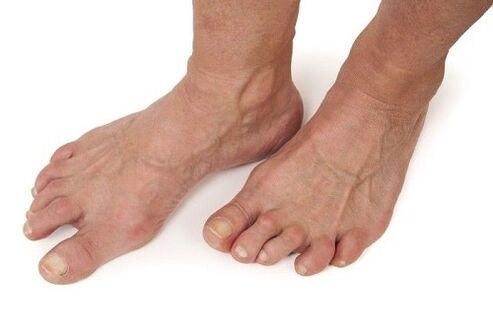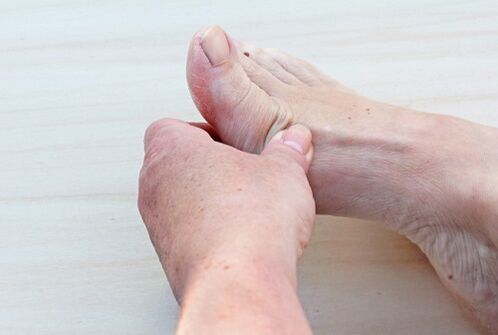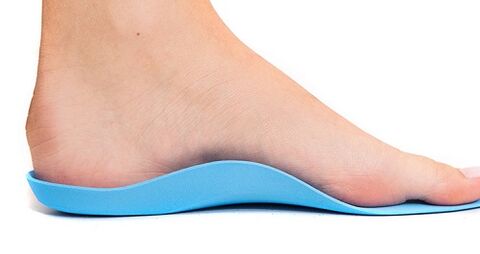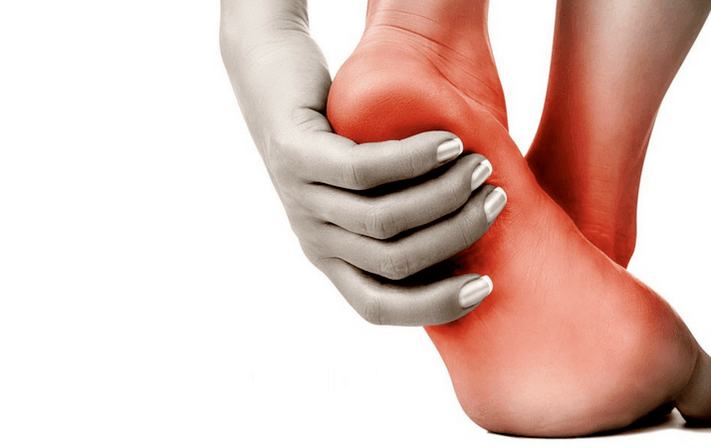Osteoarthritis of the foot is one of the most common types of pathology, which is localized in the articular apparatus of the distal lower extremity.
Unpleasant consequences of destructive joint disease include chronic pain and loss of motor function. Degenerative damage to joint tissues occurs after regular heavy loads on the foot, and as a complication after injuries and accompanying diseases. Osteoarthritis is accompanied by pain and deformity of the feet.
Treatment consists of correction with orthopedic insoles and alleviation of symptoms with medication.
What is it?
In simple words, arthrosis of the foot is a severe damage to the joints of the arch of the foot, associated with gradual degeneration and complete destruction of cartilage tissue in them. In addition to the intense pain syndrome that accompanies the pathology, it ultimately leads to the inability of the foot to fully function, the loss of its depreciation and other functions, and, consequently, the patient's disability.
Causes
The causes of osteoarthritis of the ankles are mainly poor blood flow, deterioration of supporting tissues due to injuries or changes in age. For effective treatment, you need to know what causes osteoarthritis of the feet.
The main causes are described below:
- Excessive weight, which creates more pressure on the ankles.
- Deterioration of bone and cartilage tissue over the years.
- Genetic predisposition.
- Walking in tight or oversized shoes.
- Individual characteristics of the feet: large width, curvature of the toes, flat feet. In addition, the cause may be different leg lengths.
- Excessive mechanical load on the limbs, characteristic of people who prefer hard physical work or some sports.
- Traumatic leg lesions, muscle sprains.
- Constant cold action.
- Wear high heels.
In addition, the following causes of osteoarthritis of the foot are distinguished:
- allergies and autoimmune diseases;
- displacement or congenital anomaly of the hip bone;
- hormonal and endocrine disorders in the body;
- lack of useful and vital elements;
- chronic infectious lesions of the limbs.
This disease cannot be completely cured, but it is quite possible to significantly improve the vital qualities of the patient by stopping further degenerative tendencies. In this regard, osteoarthritis of the foot should be treated after determining the primary signs of the disease.
What is the risk of damage to the feet from osteoarthritis?
In the absence of competent and timely treatment, osteoarthritis of the ankles progresses quite quickly, which leads to the destruction of cartilage tissue and inflammatory processes in the muscles.
This is accompanied not only by severe pain, but also by deformity of the feet, growth of bone tissue in the joints. As a result, mobility is lost to the point that it is completely impossible to move the foot. This leads to disability, inability to move independently, as well as psychological discomfort due to feelings of inferiority.
Symptoms of osteoarthritis of the foot
Osteoarthritis of the feet is accompanied by different severity of symptoms, the degree of manifestation of which depends on the stage and severity of the lesion. As a rule, the disease begins gradually and for a long time can not show external signs.
In addition to leg fatigue after a long walk, there are also minor signs of deformity: the formation of a small bony protrusion in the metatarsophalangeal joint of the thumb, a change in the shape of the toes. A person may experience these signs as an unpleasant cosmetic defect and be unaware of the presence of a destructive disease.
The main symptoms of osteoarthritis of the feet:
- After waking up there is stiffness in the joints, they lose mobility, after a short warm-up the foot regains flexibility;
- In the later stages of the pathology, the range of motion decreases sharply, the person inadvertently tries to relieve the sore leg, due to which the gait is disturbed and lameness appears;
- Painful pain as a result of long-term physical effort, after thorough destruction of the joint, the pain syndrome is constantly present;
- Painful pains may occur with a change of weather or hypothermia of the legs;
- The affected area occasionally swells, with inflammation of the joints, hyperemia appears, the skin becomes hot to the touch;
- Creaking is heard during foot movement, due to lack of synovial fluid and the presence of bone deformities in the joint;
- Gradually, the degenerative process spreads to the periarticular tissues, creating dense cysts in the muscles;
- Blisters appear on the soles of the feet;
- The person intuitively spares the sore leg, which leads to muscle atrophy and reduced blood circulation;
- Osteoarthritis of the feet is accompanied by rapid fatigue of the legs after prolonged standing in one place or short walks.
The lack of therapeutic measures contributes to the progression of pathological processes. Persistent changes in cartilage structure and joint structure lead to the appearance of a characteristic clinical picture.
Diagnosis
X-ray technique is of crucial importance in the matter of diagnostics. In medicine, the classification of X-ray stages of arthrosis of the foot is used, which was proposed in 1961 by a doctor of medical sciences, professor, a leading specialist in the diagnosis of osteoarticular pathologies. It includes three phases:
- Initial, in which the radiograph shows a slight narrowing of the inter-articular gap, noticeable only in comparison with a healthy joint, and a weak lesion of the articular cartilage;
- Phase of pronounced changes - a narrowing of the interarticular gap is clearly visible, because it becomes two or more times smaller than the norm. The destruction of cartilaginous tissue takes on a pronounced character at the places of greatest load on the joint;
- Stage of pronounced changes - X-ray shows complete destruction of the cartilage of the bone. There is practically no inter-articular space, the bone tissues of the joints are in contact with each other, they completely coincide, their surfaces are deformed, the bone growths are sharply expressed. This phase is called deforming osteoarthritis of the foot, in which the motor functions of the ankles are severely impaired.
This technique is still used when a person undergoes a medical and social examination to determine a disability group. There is another radiological classification of arthrosis according to Kellgren Lawrence, proposed in 1957.
In addition to X-rays, modern methods of instrumental diagnosis of osteoarthritis of the foot are also used. Ultrasound examination and computed tomography of the ankle joints provide additional information about the condition of the bones, cartilage and periarticular tissue in the affected area.

Treatment of osteoarthritis of the foot
It must be said immediately that the therapy should be carried out only in consultation with a doctor. Improper treatment of osteoarthritis of the foot at home, carried out by some careless patients, only worsens the course of the disease and delays recovery.
A set of procedures, including conservative and surgical techniques, is used to treat osteoarthritis of the feet. Conservative methods include:
- Drug treatment - painkillers and anti-inflammatory drugs in tablet, topical and injectable forms, chondroprotectors injected into the joint;
- Physiotherapy - ultraviolet radiation, treatment with high frequency currents, shock wave therapy, therapeutic exercises and massage, mud applications, mineral baths;
- Spa treatment.
A special problem is the treatment of osteoarthritis of the small ankles. Deformities and curvatures of the toes in osteoarthritis of the feet develop very quickly, make it difficult to walk and contribute to the appearance of painful corns and calluses. Experts recommend changing shoes to be more comfortable to prevent such curvatures, as well as to consult an orthopedist who will help you choose orthopedic insoles and special splints that keep the toes in the correct position.
In the third phase of deforming arthrosis of the foot, it is too late to take pills and apply physiotherapy, because in this phase, the treatment of arthrosis of the feet with drugs can no longer give a lasting positive result. First, the cartilaginous membrane was completely destroyed, and then the bone tissue of the joint. Also, one of the consequences of arthrosis of the feet are pathologies of the spine (curvature, herniated intervertebral discs) due to persistent posture and gait disorders.
Surgical treatment methods are used to restore normal motor functions of the joint. This may be surgery to remove cartilage remnants, artificial closure of the joint to immobilize it to prevent further destruction of the bone, partial replacement of the joint tissue with artificial. A radical method of treatment involves complete replacement of the joint with an endoprosthesis. But all these manipulations are performed only with a large joint - the ankle joint.
Lifestyle change
The patient should reconsider his habits in everyday life that contribute to and provoke the progression of arthrosis of the feet. Without it, drug treatment will not have the desired effect. Painkillers and anti-inflammatory drugs will only eliminate the symptoms of the disease, but the pathological process itself will progress.
The first important point in lifestyle changes is to reduce stress on the affected joint. The load on the joints, first of all, must be reduced in order to prevent the progression of the disease and stabilize the process. This can be achieved by changing certain habits and lifestyles.
The most important rules for reducing the load on the foot are the following:
- avoid long walks;
- alternating walking with a rest of 5 minutes;
- not standing for a long time in one place (static load on the affected joint is much worse than dynamic);
- frequent descents and climbing stairs are not recommended, if possible, use the elevator more often;
- do not carry weights;
- use a stick.
Another important point is weight loss. As mentioned above, in obese patients, osteoarthritis of the feet progresses much faster due to the greater load on the joints when walking. For treatment, it is important to determine the so-called body mass index (BMI) and try to normalize this indicator.
Treatment of osteoarthritis of the foot with drugs
Methods of treating osteoarthritis of the foot at home come down to taking certain medications. They partially eliminate the symptoms of the disease, help improve joint nutrition. The problem is that cartilage and bone deformities are very difficult to repair. Most often, complete correction requires surgical intervention. However, treatment tactics depend on the stage. Before the pronounced changes in the joint, the main method is drug treatment.
Prescribing medications can cause the development of gastropathies that are manifested by erosions and ulcers on the stomach and duodenum. Risk factors for complications are age, the presence of peptic ulcer and chronic gastritis in the past, the simultaneous use of 2-3 drugs from this group at once.
To prevent exacerbations, the following are prescribed in parallel:
- Proton pump inhibitors.
- H2 histamine receptor blockers.
Chondroprotectors are used to improve joint function. These are drugs that improve the metabolism of articular cartilage, which slows down and prevents its destruction. The main components of such drugs are glycosaminoglycans and sodium chondroitin sulfate. All chondroprotectors are used for long courses - from 1 month to six months. After a break of 2-3 months, the treatment should be repeated.
In addition to tablets, capsules and injections, which act systemically (on the whole organism), local therapy is also applied. It comes down to the use of ointments and creams. In addition, some drugs are injected directly into or near the ankle. This treatment usually gives a faster and more stable effect.
The following methods can be used for local therapy:
- intraarticular and periarticular administration of glucocorticoids;
- intra-articular administration of hyaluronic acid preparations;
- topical application to the affected joint area ointments (gels, creams), based on nonsteroidal anti-inflammatory drugs.

Physiotherapy
The following physiotherapeutic procedures are used in the treatment of patients with osteoarthritis of the feet:
- Pulse magnetotherapy - inductors are placed on both sides of the affected joint and move slowly for 5 to 10 minutes. The course consists of 10 procedures.
- Application of heat transfer fluid - during such procedures, the temperature of the tissues that are exposed increases. Cartilage metabolism is activated, its regeneration is stimulated. Applications of peat sludge up to 40 degrees, paraffin and ozokerite up to 55 degrees are used. Such procedures are performed in 10 - 15 one course of 20 minutes.
- Electrophoresis - lidocaine, analgin, sodium salicylate. The duration of exposure is 20 minutes a day. The course consists of 15 procedures.
- Ultraphonophoresis - hydrocortisone, analgin. Duration 5 minutes per affected joint. The course of treatment consists of 10 procedures.
- Infrared radiation - for 5-8 minutes on the sore joint daily for 10 days.
gymnastics
In the acute period of arthrosis of the feet of the lower extremities, the legs are at rest. However, as soon as the pain subsides, it is necessary to start exercise therapy.
Exercises that can be performed for osteoarthritis of the feet at home:
- alternately pull the socks away from you and towards you;
- make circular movements with your thumb;
- squeeze your toes as tightly as possible and also unhook strongly;
- try to pick up small objects from the floor with your toes.
If the patient has osteoarthritis of the small ankles, movement therapy (kinesitherapy) is considered essential. In the beginning, it is better to study with an instructor - he will show you what to do and how to do it
Wear special shoes
In addition to the complex treatment of osteoarthritis of the foot, doctors prescribe the constant wearing of special shoes. It is easy to find orthopedic boots, shoes and even slippers for home use on sale.
Specially designed braces and insoles support the foot in the desired position and add shock absorption when walking, while prostheses and additional inserts fix the ankle joint, preventing further deformations of the articular cartilage and the development of toe arthrosis.

Folk remedies
The following folk remedies are most effective for the treatment and prevention of osteoarthritis:
- Potato wraps. They are mainly used to relieve swelling and pain in the affected joint area. The potatoes are well washed and chopped without peeling. Then throw in warm water (40-50 degrees) and soak for a few minutes. The resulting mass is wrapped in cloth and applied to the affected joint twice a day.
- Angelica root baths. The angelica root is crushed and wrapped in a cloth (folded gauze several times). 250 - 300 g of roots are needed for 5 liters of water. The fabric is placed in a bowl with warm water and wait for the water to cool to a temperature of 30-40 degrees. After that, foot baths are made for 10 to 15 minutes. In this case, the bag is not removed.
- Fir oil. Fir oil is thoroughly rubbed into the affected joint area twice a day. For the best effect, it is recommended to apply a heating pad before rubbing in the fat.
- Garlic juice. A few cloves of young garlic are ground until a pulpy and vegetable oil is added. The resulting mixture is applied in a thin layer on the sore wrist before bedtime and a bandage is applied.
- Coniferous balm. This tool helps to improve the metabolism in the cartilage tissue, delaying the deformation of the joint. To prepare the balm, 50 g of young needles are poured with 2 liters of boiling water. The mixture is boiled for 15 to 20 minutes on low heat. In that case, you can add a teaspoon of garlic juice, crushed rods, finely chopped licorice root. The soup is infused in a thermos for 18 - 20 hours. After that, strain it through gauze, cool it in the refrigerator and drink 0. 5 - 1 liter per day for a week.
- Hops and St. John's wort ointment. To prepare the fat, grind 10 g of washed St. John's wort and hops well. Add 50 g of Vaseline oil to the obtained porridge and mix well until a homogeneous mass is obtained. The ointment is applied to the joint area twice a day.
These products are recommended for people at risk of developing osteoarthritis of the feet. First of all, these are patients suffering from rheumatoid arthritis and other inflammatory diseases of the joints. As a preventive measure, these recipes can also be used by the elderly, athletes, patients after a fracture or sprain of the ankle.
Operation
Osteoarthritis of the feet refers to chronic pathologies that gradually progress and worsen degenerative processes. In the 3rd stage of the disease, the disorders are so pronounced that the cartilage tissue is completely destroyed and cannot be restored with medication. Only surgical methods are used to remove deformities, severe pain, and restore the ability to walk. Other treatments are ineffective.
Modern types of surgical interventions:
- Arthroscopy. The arthroscope is inserted into the intra-articular cavity - this is a special device that allows you to examine the joint from the inside. The doctor removes all foreign elements from the synovial fluid: cartilage particles, bones or blood clots. Manipulation reduces the intensity of pain, but provides only temporary relief. The pain returns within 6-12 months. It is mainly used by young people;
- Arthrodesis. During the operation, the remaining cartilage is removed, and the joint is fixed in one position. Gradually, the bones merge in a given position, so ankylosis occurs. The ankle is completely eliminated, which leads to immobility of the feet, but the elimination of pain, inflammation and the ability to walk, although the quality of movement is still low. The technique is rarely used;
- Endoprosthetics. It is used exclusively in stage 3 of the disease, when there is practically no more cartilage. The method consists of implant placement. Its shelf life reaches 10-15 years, depending on the type of material used. Endoprosthetics allow you to fully restore your quality of life.

Is it possible to completely cure osteoarthritis of the feet?
It is believed that it is impossible to completely deal with osteoarthritis of the feet. Destroyed cartilage no longer grows. All therapy is aimed at maintaining the existing condition of the joint and preserving it in the form in which the patient came to the doctor.
A doctor can only stop the process, but not rebuild the tissue. If you follow the recommendations, the patient will not feel restrictions on movement, and only negative external factors or ignoring the doctor's advice can again cause discomfort in the legs.
Prevention and complications
To rule out the appearance of an unpleasant disease, you need to follow simple rules. One of them is a healthy lifestyle. To prevent osteoarthritis it is necessary:
- reduce the amount of salt you eat;
- organize proper nutrition;
- limit excessive physical activity;
- get rid of extra pounds;
- strengthen immunity to rule out inflammatory, infectious diseases.
Preventive methods for the development of osteoarthritis include:
- avoiding lower extremity injuries;
- exclusion of hypothermia of the legs;
- sole massage;
- use of comfortable shoes with flexible soles, orthopedic insoles;
- removal of high heels;
- performing gymnastics for the ankles;
- walking barefoot on grass, sand;
- timely treatment of inflammatory diseases.
The disease can be complicated by pathologies such as arthritis, bursitis of the feet, inflammation of the periarticular bursa. Osteoarthritis of the feet leads to deformity of the toes, in a neglected state it becomes a reason for immobilization of the feet and disability of the patient.
Forecast
With timely diagnosis of osteoarthritis of the foot and properly selected treatment in the early stages, the prognosis is favorable. Despite the fact that cartilage destruction is irreversible, further progression of the pathology with joint destruction can be prevented. Osteoarthritis in the later stages has an unfavorable prognosis, foot functions are lost, disability can be avoided only by replacing the destroyed joint with an artificial one.



































